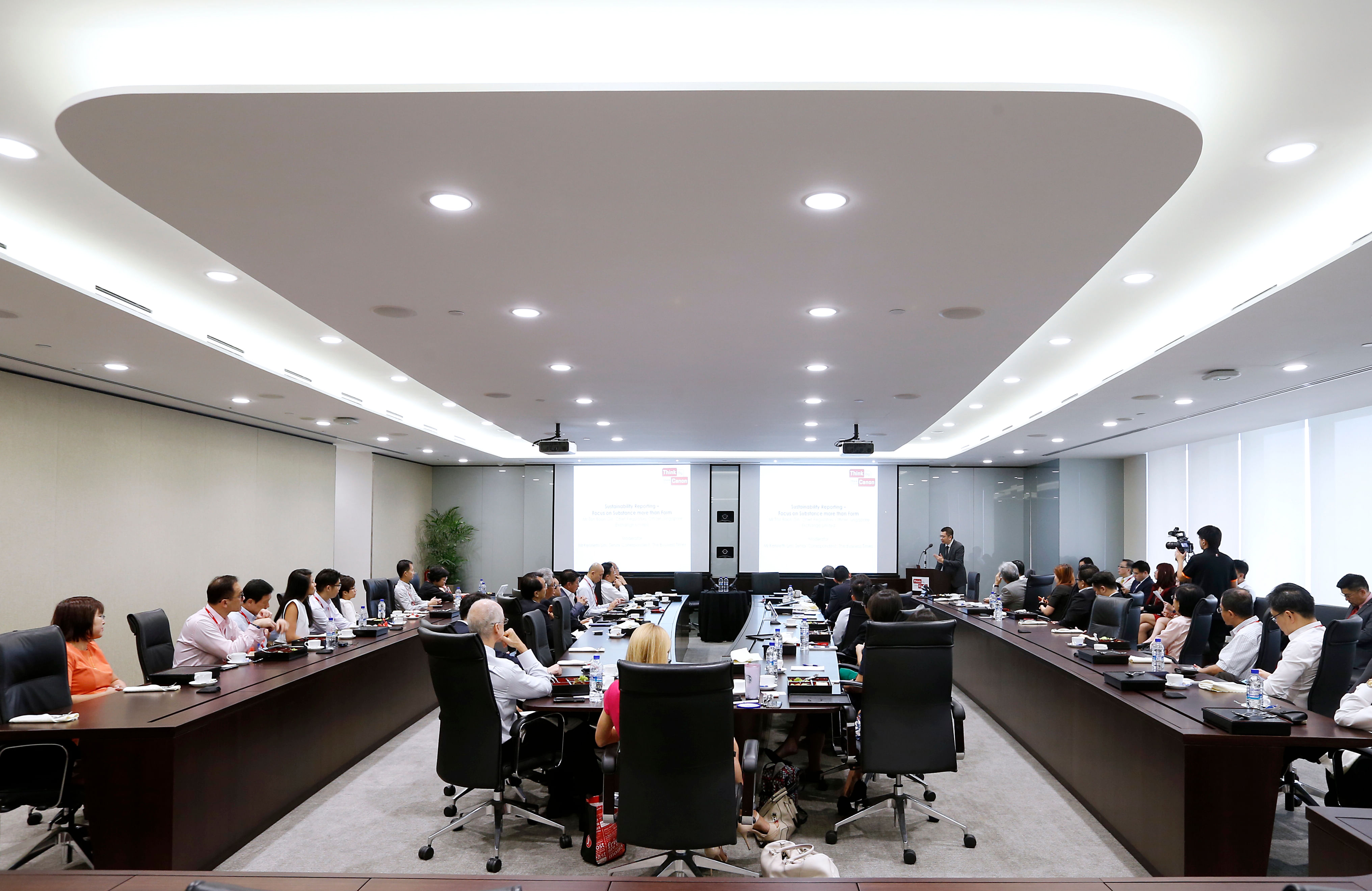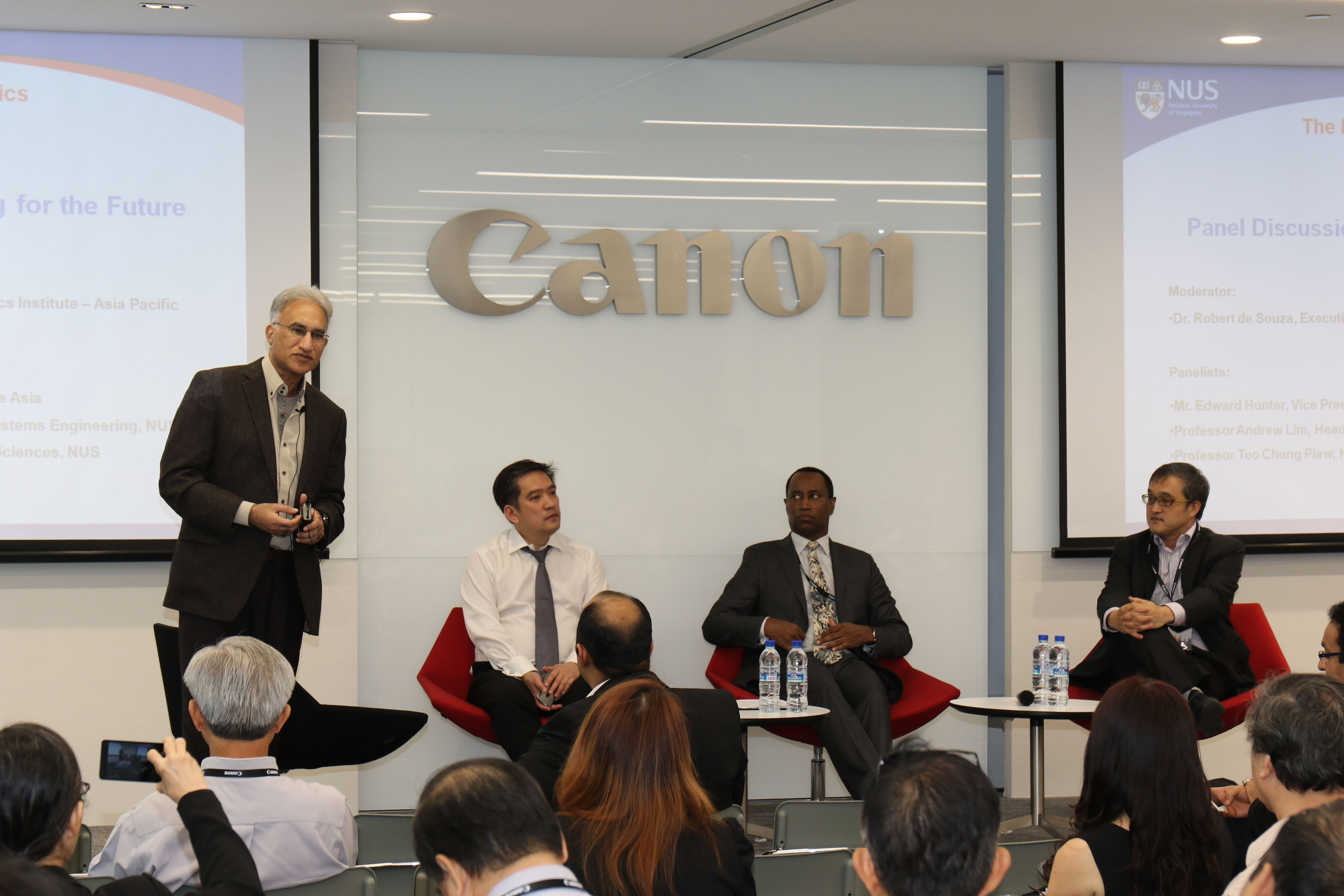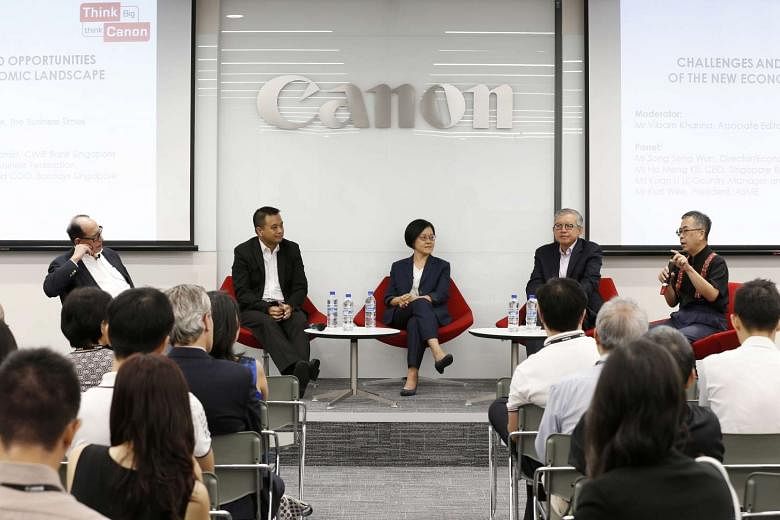Reaching out into foreign markets and engaging in research and development (R&D) are two ways in which local firms, especially small and medium enterprises (SMEs), can grow their businesses farther. However, firms also need better access to funds in order to expand.
These views were shared by economists and business leaders who spoke at the Singapore Future Economy, a talk attended by more than 200 business representatives and leaders from the private sector.
The session, held on March 22, was part of the Canon Think Big Convention 2016 that was jointly organised by The Business Times and Canon. Singapore saw its economy grow 2 per cent in 2015, the weakest rate of growth since 2009 and down from the 3.3 per cent growth in 2014.
Growth this year is likely to stay within the 1 per cent to 3 per cent range, said the Ministry of Trade and Industry (MTI) previously.
Amid this backdrop, the Committee on the Future Economy, a high-level task force headed by Finance Minister Heng Swee Keat, will look at how Singapore's economy can restructure itself.
One way to do so is to encourage local firms to tap into markets overseas, said CIMB private bank economist Song Seng Wun, who was a speaker at the talk.
"Domestically while we are seeing slower growth, there are some opportunities outside that can help," said Mr Song. "I would say for the next 50 years, there are more chances for contributions by investments from companies outside of Singapore to contribute to its growth."
This way, having firms expand overseas can become the next growth driver for Singapore, said fellow speaker Ho Meng Kit, chief executive officer of Singapore Business Federation (SBF).
"No point continuing to bring multi-national corporations into Singapore, because we're already out of land and labour - business costs continue to go up. So what we should do is to exploit the opportunities outisde of Singapore," said Mr Ho, summarising a recommendation detailed in a position paper that the apex business chamber of the city-state has recently put out.
Innovation, specifically among SMEs, was another possible growth engine that the speakers saw. For example, Canon has been able to grow its business through innovation, said Melvyn Ho, senior vice president and head of Singapore operations of Canon Singapore.
While the company started out as one that traded in hardware, it reinvented itself to also provide modern business solutions and services.
Mr Ho added: "So reinvention for relevance applies to any business looking to be ready for the future. SMEs, by virtue of their lean set-up, are quick and responsive to the market. The challenge is often about what more you can do to create efficiencies in your business."
In SBF's view, certain public organisations can collaborate to set up a new agency that channels public funds into R&D for the private sector, and also looks into how local enterprises can innovate.
These organisations can also involve key stakeholders such as research institutes, famous researchers and licensing agencies for intellectual property (IP) rights in their endeavour to build up R&D capabilities in the private sector.
In 2014, R&D expenditure of small and medium-sized enterprises (SMEs) rose 38 per cent to a new peak of S$800 million, according to A*Star. This means that smaller firms led 2014's growth in private-sector spending on R&D.
But there were still limits on how such expenditure by SMEs can be used wisely.
For example, many SMEs turn to universities to collaborate on R&D. "But the pace and depth of R&D is sometimes not deep enough, because they (students) are still learning too," said Association of Small and Medium Enterprises president Kurt Wee, who was also a panellist at the event.
SMEs also face difficulties in understanding what R&D grants are available to them, added Mr Wee.
As to why many SMEs also often find it difficult to look to banks for funding for expanding their operations or acquiring another company, Kuan Li Li, country manager and chief operating officer of Barclays Singapore, said that banks would have to look at the firms' risk profiles to determine whether it should lend to a certain company.
"You really have a lot of difficulty when buying into a new company when it has very poor record keeping practices - that may be the reason why you can't get the funding that you want," said Ms Kuan.
At the same time, the corporate financing scene has evolved to provide more avenues for firms to raise funds, said Ms Kuan. Some of these include crowd-sourcing and platforms that pre-sell business ideas to gauge market interests.
But Ms Kuan noted that more can be done to help SMEs find out which grants and forms of help are suitable for them, so that their expansionplans will not be stymied by the lack of funds.
"I think too much segmentation makes it very difficult for businesses to know who exactly to go to for what sort of help," she said. "For an SME, all I want to do is to go to one place and say, 'This is my problem, tell me what I need to do.'"
SGX keen to help firms file sustainability reports

The Singapore Exchange (SGX) is looking to adopt a carrot-and-stick approach to get companies to file sustainability reports every year. SGX's chief regulatory officer Tan Boon Gin said at a breakfast talk held in conjunction with the Canon Think Big Convention that the bourse operator is thinking of introducing programmes to show companies how these reports can be produced: "We are thinking of ways to help companies, and this could be along the lines of training, providing templates or giving them lead time."
But if companies do not fall in line?
"If we ultimately have to enforce (the requirement) because the company ignores us - which we hope won't happen - then we do have the full gamut of enforcement tools at our disposal."
The breakfast talk was attended by more than 30 business leaders from listed companies, and was jointly organised by The Business Times and Canon.
Sustainability reports are expected to cover material environmental, social and governance (ESG) issues. The SGX had, in a consultation paper in January, announced plans to make companies produce such reports on a "comply-or-explain" basis next year; they would be due at least once a year, no later than five months after the end of a company's financial year.
Mr Tan said during Tuesday's session, which was moderated by BT senior correspondent Kenneth Lim, that there is now a growing movement towards ESG disclosure worldwide.
It had started out as an expression of concern among shareholders and businesses that these issues can affect companies' bottomlines, but the movement has since taken on a regulatory tone.
In the climate-change agreement inked last year in Paris, for instance, governments put pressure on businesses to disclose their carbon-reduction strategies.
Mr Tan said: "ESG risks are as real as any other financial or operational risks that need to be discussed."
It is why SGX is proposing that companies publish such reports yearly - a shift from 2011, when it introduced guidelines for sustainability reports which companies could voluntarily file.
Highlighting Canon's corporate philosophy of kyosei, or living and working together for the common good, president and chief executive officer of Canon Singapore Mr Kensaku Konishi said at the talk that the company has always been mindful of its responsibility to its customers and community in Singapore.
Throughout its three-decade old presence here, Canon has introduced initiatives to reduce waste, help the community, and even moved into a new environmentally-friendly building last year that has already won an award for its green technology.
"Doing business sustainably is essential for longevity, it is no longer a luxury or as sideline. Sustainability, when incorporated as part of a company's strategy, drives growth," said Mr Konishi.
The SGX's proposed regime will let companies decide what they consider to be material ESG risks that should go into the report; they can also decide on the form these reports can take.
Companies that exclude one or more of the primary components must explain the reasons for it. Consultations based on the SGX paper have now closed. Mr Tan did not comment on the feedback that was received.
He said companies are familiar with ESG risks, and that these reports should bring the issues into focus for the companies, their stakeholders and partners.
Concerns about the cost of compliance are sometimes overstated, he said, indicating that the SGX would help companies to draft their reports, through talks, workshops, providing templates or sharing the best practices of companies.
Companies that do not comply may be fined or denied access to the market, said Mr Tan. He added, however, that in the course of prodding companies to produce these reports, the SGX would not be too prescriptive in its approach, and that over time, "I think we will see quite a lot of work ... and I suspect the market will eventually shape disclosures towards that".
History is future in logistics

History, it turns out, will be key to the future in logistics.
By understanding what sort of management decisions have been made in the past, supply chains can be better managed as the world moves towards a more fragmented future, said experts at a talk titled "Future of Logistics", held on March 22.
"Through real-time analytics, by looking at the history of your replenishment activities, and then adapting your decisions on the fly, it actually turns out to be a far better solution in supply chain management," said Teo Chung Piaw, professor and head of the decision sciences department at National University's Business School. Prof Teo and other panellists were sharing their views on how Singapore's logistics industry can become more competitive globally in the new knowledge-based economy. The talk was part of the Canon Think Big Convention 2016 that was jointly organised by The Business Times and Canon.
Singapore's logistics sector has not had a good year thus far.
Faced with cost pressures from high wages and high operating costs, players in the market are also seeing a dip in demand from their customers. The Singapore Logistics Association (SLA) had said that the slowdown in trade and the manufacturing sector is being "keenly felt, especially amongst small and medium-sized (logistics) enterprises".
Coupled with this is the larger picture of a changing consumer landscape, as the rise of e-commerce makes it even harder for a one-size-fits-all approach to delivering goods into the hands of the consumer, who used to congregate in shopping malls.
"Asset efficiency is key, and the consumer is driving us to respond in a different way," said Edward Hunter, vice-president of product supply for Procter & Gamble Asia, who also spoke at the event. "I think that's why we're all trying to find ways to be more efficient in matching demand and supply."
The fragmentation of the consumer market has deep implications on how logistics players can respond, said Prof Teo. As they move towards a more demand-driven future, data analytics can help logistics players to have a better understanding of previous decisions made in supply management. This helps the company make more informed decisions in how to use their resources when delivering goods. This way, economies of scale is no longer a major concern in the logistics sector, while the optimal usage of resources becomes key, said Mr Hunter.
As Singapore's economy restructures, Mr Hunter is optimistic that the focus on data analytics will help the logistics sector develop into a more vibrant one.
"Now, no matter if you're a small operator or a large operator, you can compete," he said. The discussion was moderated by Dr Robert De Souza, Executive Director of The Logistics Institute - Asia Pacific, NUS.
In another session, the audience learnt about a new cloud-based solution from Canon that can help firms, especially smaller ones, to optimise resources. Called "FleetnexG", the software-as-a-service provides real-time tracking of deliveries and helps automate the process of scheduling vehicle fleets. This will result in enhancing productivity and also generate time and cost savings for smaller firms. It also helps to shorten the bill collection cycle, thus improving cash flows for businesses.
"With FleetnexG, Canon hopes to deliver a smart and practical solution to harness the tangible benefits of real-time data for resource optimisation, without the daunting costs of implementation," said Vincent Low, director of business imaging solutions at Canon Singapore.

